
All images © by Roberto Piperno, owner of the domain. Write to romapip@quipo.it.
Notes:
Page added in April 2024.

All images © by Roberto Piperno, owner of the domain. Write to romapip@quipo.it.
Notes:
Page added in April 2024.
 Frescoes of Villa Giustiniani Massimo
Frescoes of Villa Giustiniani MassimoYou may wish to see a page on the architecture and external decoration of Villa Giustiniani Massimo first.
Naples, May 1787. At Count Fries's, besides dealers in art, you met a species of literati strolling about in Abbé costume. There was no agreeable conversation with them. I had scarcely broached the subject of national poetry and endeavoured to gain instruction on one and another point, when all at once, without any beating about the bush, the question was started, which was the greater poet, Ariosto or Tasso? If you answered, "God and Nature be praised that favoured one nation with two such excellent men, each of whom, in accordance with his time and situation, with his talents and sentiments, has afforded us the most splendid experiences, has calmed and delighted us," a rational word of that kind would pass with none of them. The poet they had decided for was extolled higher and higher, the other being disparaged lower and lower. At first I tried to defend the depreciated poet, and make good his excellencies. My learned friends were not, however, to be put off their game; they had taken sides, and would not budge an inch from their position. The same assertions being now repeated over and over again, I, too much in earnest for dialectic controversy on such subjects, withdrew myself altogether from the conversation, especially when I perceived how it was all mere phrases which, without any particular interest in the subject, each went on pronouncing and asserting.
The case, however, was much worse when Dante turned up for discussion. A young man of position and talent, possessing also some real sense of that extraordinary man, did not take my expressions of esteem and admiration with the best good grace, assuring me, as he did with all complacency, that no foreigner need try to understand so extraordinary a mind, the Italians themselves being unable to follow him in every particular. After some speech back and forward, I at last got out of humour, and confessed I was disposed to agree with him, as I had never been able to comprehend how any man could take up his time with those poems. "The Hell was to me altogether horrible, the Purgatory neither one thing nor another, and the Paradise dreadfully slow." This greatly pleased him, showing as it did the justness of his observation, and how incompetent I was to fathom the height and depth of such poems. We parted the best of friends, he even promised to communicate and explain to me some hard passages he had long been cogitating, and had at last made out.
J. W. Goethe - Italian Journey - Translation by Charles Nisbet
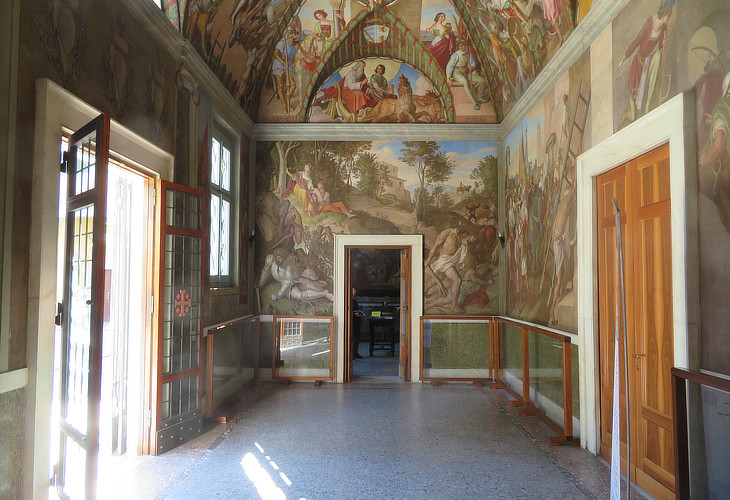
Ariosto's Room (previously an open loggia) and door leading to Dante's Room
The anecdote by Goethe explains why in 1817 Prince Carlo Massimo chose to decorate three rooms of the Casino with scenes from the poems by Dante, Ariosto and Tasso. He commissioned the frescoes to German painters who in 1809 had formed a brotherhood (Lukasbund) in opposition to Accademia di S. Luca, the official guild of Roman artists, with the aim of bringing painting back to the simplicity and neatness of the Early Renaissance. They initially lived at Convento di S. Isidoro which the French had closed and eventually they opened their studios in nearby Via Gregoriana. They were called Nazarene because of the poverty of their clothes and in general of their aspect. Prince Massimo might have been introduced to them by Bertel Thorvaldsen, the Danish sculptor who lived and worked in the same neighbourhood. Most of the Nazarene painters eventually returned to Germany and Austria where they were given important posts at the courts, academies and universities of their countries. This increased the interest of travellers to Rome for their early works.
The central casino contains interesting frescos by distinguished German artists of the cinquecento school, or,
as it is sometimes called, the Christian school of art,
the subjects of which are taken from Dante, Ariosto
and Tasso. One room contains subjects from the Divina
Commedia, by Koch and Ph. Veit; another from the Orlando Furioso, by Schorr and the third, from the
Gerusalemme, by Overbeck and Fuhrich.
Rev. Jeremiah Donovan - Rome, ancient and modern: and its environs - 1843
Opposite Palazzo del Laterano is the entrance of the Villa Massimo Arsoli, to which admission may be obtained by a permesso given at the Palazzo Massimo alle Colonne. There is little to see here, however, except a casino beautifully decorated with scenes taken from the great Italian poets by the modern German artists, Schnorr, Kock, Ph. Veit, Overbeck, and Fuhrich.
Augustus J. C. Hare - Walks in Rome - 1874
Collections, Villas, etc. (..) Massimo, Villa (p. 276), frescoes: admission rarely granted. (..) The grounds are neither very extensive nor interesting, and the antiquities in the passages are of little value; but the ground-floor of the *Casino contains some valuable Frescoes from the great Italian poets, painted for Prince Camillo Massimo in 1821-28 by German artists.
Karl Baedeker - Handbook for Travellers in Central Italy - 1883.
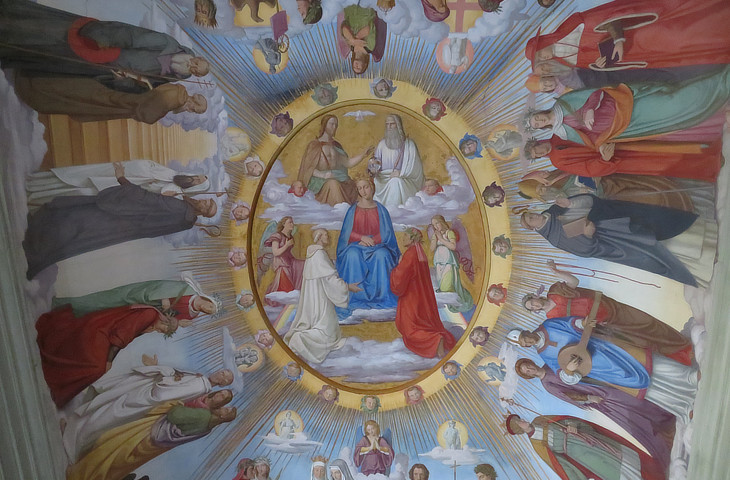
Dante's Room (ceiling): Philipp Veit, Representations from Paradise (Canto XXXIII) 1819-1824: in the central oval Dante and St. Bernard in the final scene of the Paradise where they see the Trinity and the Virgin Mary
Philipp Veit (1793-1877) joined the Lukasbund in 1816 shortly after having converted to Catholicism. In 1821 he married a young girl, Carolina Pulini (1807-1890), the daughter of his landlord and in 1830 he left Rome for Frankfurt and eventually Mainz. He is credited with having developed the technique of the overall decoration of the casino, i.e. fresco with tempera retouching. The Nazarenes sought inspiration in the works by il Perugino and Raphael, but in the depiction of the Paradise, Veit might have been influenced also by il Beato Angelico, because of the intensity of his religious feelings.
"Thou Virgin Mother, daughter of thy Son,
Humble and high beyond all other creature,
The limit fixed of the eternal counsel,
Thou art the one who such nobility
To human nature gave, that its Creator
Did not disdain to make himself its creature.
Within thy womb rekindled was the love,
By heat of which in the eternal peace
After such wise this flower has germinated.
Dante - Paradise - Canto XXXIII - translation by Henry Wadsworth Longfellow (1867)
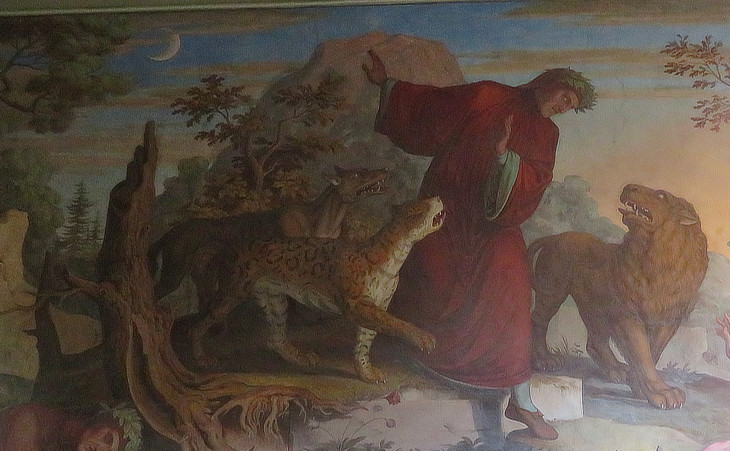
Dante's Room: Joseph Anton Koch, Hell: Dante threatened by a lion, a panther and a she-wolf (Canto I), 1825-1826; the image used as background for this page shows Dante falling asleep
Joseph Anton Koch (1768-1839) came to Rome in 1795 and specialized in landscape paintings. Apart from a stay in Vienna in 1812-1815 he lived in Rome and its environs in particular at Olevano, the birthplace of his wife and a location preferred by many landscape painters, including Edward Lear. His grandson Gaetano Koch was one of the leading Roman architects of the end of the XIXth century.
And lo! almost where the ascent began,
A panther light and swift exceedingly,
Which with a spotted skin was covered o'er!
(..) So were to me occasion of good hope,
The variegated skin of that wild beast,
The hour of time, and the delicious season;
But not so much, that did not give me fear
A lion's aspect which appeared to me.
(..) And a she-wolf, that with all hungerings
Seemed to be laden in her meagreness,
And many folk has caused to live forlorn!

Dante's Room: Joseph Anton Koch, Hell: Minos, the judge of the infernal regions, surrounded by the damned (Canto V) 1827-1828
Koch was the most senior member of the group and the most acquainted with the Italian Renaissance masters. His depiction of Hell reflects some aspects of Luca Signorelli's Last Judgement in the Cathedral of Orvieto.
Thus I descended out of the first circle
Down to the second, that less space begirds,
And so much greater dole, that goads to wailing.
There standeth Minos horribly, and snarls;
Examines the transgressions at the entrance;
Judges, and sends according as he girds him.
I say, that when the spirit evil-born
Cometh before him, wholly it confesses;
And this discriminator of transgressions
Seeth what place in Hell is meet for it;
Girds himself with his tail as many times
As grades he wishes it should be thrust down.
Minos, King of Crete was a judge of the Underworld in the Greek and Roman tradition, but he did not have such beastly features as those imagined by Dante.
Nearby are those condemned to die on false charges.
Yet their place is not ordained without the allotted jury:
Minos, the judge, shakes the urn: he convenes the voiceless court,
and hears their lives and sins.
Virgil - The Aeneid - Canto VI - Translation by A. S. Kline
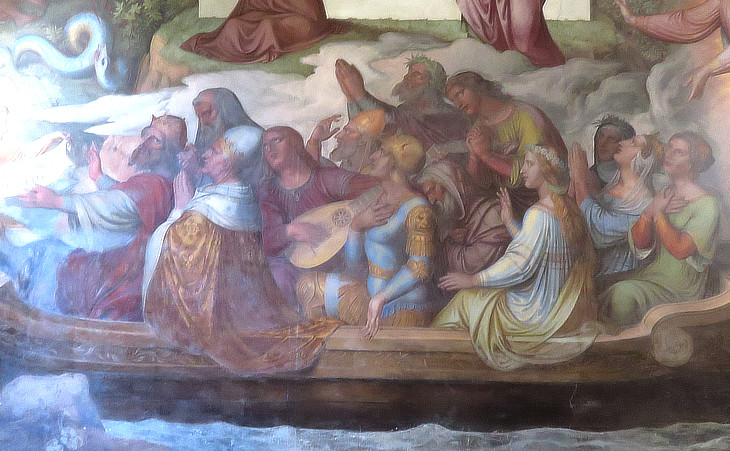
Dante's Room: Joseph Anton Koch, Purgatory: Boat with souls about to do penance (Canto II) 1828
This scene is more similar to those painted by his colleagues in the other rooms and it shows the influence of Raphael on the Nazarene movement.
(..) and he came to shore
With a small vessel, very swift and light,
So that the water swallowed naught thereof.
Upon the stern stood the Celestial Pilot;
Beatitude seemed written in his face,
And more than a hundred spirits sat within.
"In exitu Israel de Aegypto!"
They chanted all together in one voice,
With whatso in that psalm is after written.

Dante's Room: Joseph Anton Koch, Purgatory: Omberto Aldobrandeschi enduring penance for his pride, one of the seven mortal sins (Canto XI) 1825-1826; "Te Deum Laudamus - We praise you, O God"
Michelangelo was not among the artists who inspired the Nazarenes, but Koch could not avoid representing nudity in the muscular form which characterized the Florentine master's works. Similar to what occurred to the Last Judgement in the Sistine Chapel some nudes were retouched after the death of Prince Massimo at the request of his sister-in-law.
Thus for themselves and us good furtherance
Those shades imploring, went beneath a weight
Like unto that of which we sometimes dream,
Unequally in anguish round and round
And weary all, upon that foremost cornice,
Purging away the smoke-stains of the world.
(..) I am Omberto; and not to me alone
Has pride done harm, but all my kith and kin
Has with it dragged into adversity.
And here must I this burden bear for it
Till God be satisfied, since I did not
Among the living, here among the dead."
The Aldobrandeschi had several fiefdoms between Siena and Viterbo. Omberto fought the attempts by Siena to seize his possessions; in 1259 he was suffocated in his bed by hired assassins.
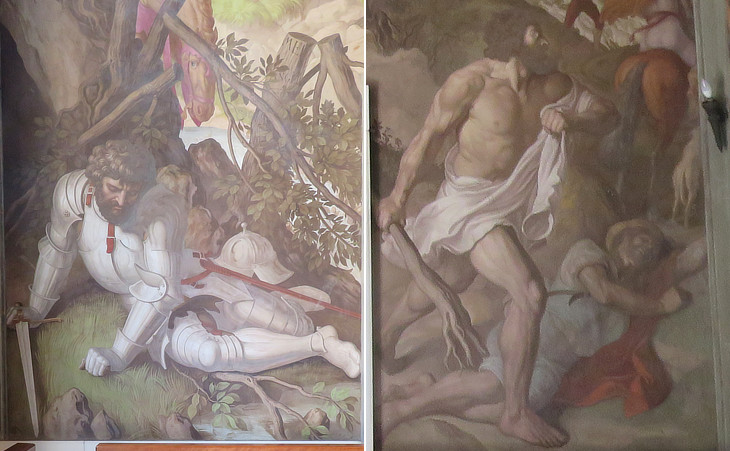
Ariosto's Room: Julius Schnorr von Carolsfeld: (left) Roland sad and mournful; (right) Roland in a state of frenzy (XXIII - XXIV) (1822)
Julius Schnorr von Carolsfeld
(1794-1872) came to Rome in 1815 with Koch and Overbeck. His decoration of the Ariosto's Room shows that he mastered complex scenes. He left Rome in 1825 and settled in Munich at the court of King Ludwig I Bavaria. In 1846 he moved to Dresden as director of the local museum of fine arts. In general he privileged religious subjects.
The setting of Orlando Furioso is borrowed from the XIth century Chanson de Roland which tells of the death of Roland at the Battle of Roncevaux. Orlando is the Italian name for Roland, the Christian knight who, in the French epic poem, fights for Charlemagne in a battle between the Christians and the invading Saracens. Furioso refers to the madness of Orlando which is caused by his learning that Angelica, whom he loves, had been in love with Medoro, a Saracen knight.
And when, at last, he felt he was alone,
Uttered his grief, in many a shout and groan.
He ceased not from his weeping and moaning,
Nor could Orlando find peace, night or day,
He shunned the towns and villages, lodging
In the woods; there, on the hard ground, he lay.
Ariosto - Orlando Furioso - translation by A. S. Kline
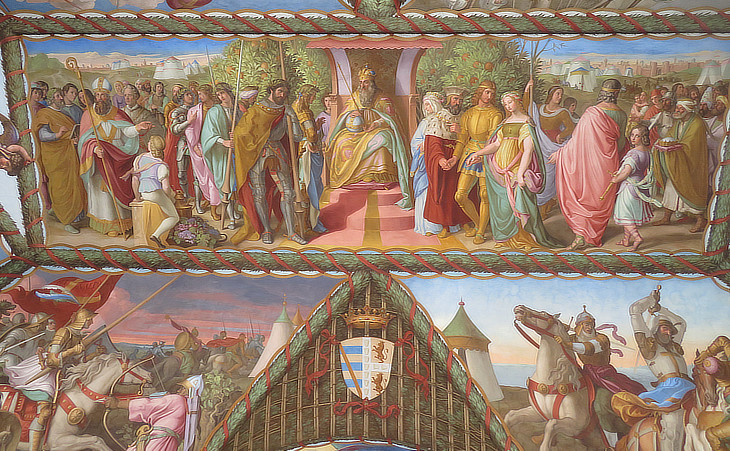
Ariosto's Room (ceiling): Julius Schnorr von Carolsfeld: (above) Nuptials of Ruggiero and Bradamante and celebration of victory (XLVI); (below) scenes of battles between Christian and Saracen knights and coat of arms of the Massimo (see it at Palazzo Massimo alle Colonne) (1822-1823)
The tales about Charlemagne and his Paladins were very popular in Italy and some locations were associated with Roland e.g. at Sutri, Rome and Gaeta. In 1780 the Chigi decorated a room of their palace at Ariccia with scenes from Ariosto's poem.
Rich and royal nuptials they prepared,
To him who undertook them most fitting,
For Charlemagne in all that pleasure shared,
As if it was his own daughter's wedding.
Canto XLVI is the final one; it describes the marriage between Ruggiero, a knight who is grandson of Agolante, a Saracen king of Africa, but also a descendent of Alexander the Great and Hector and Bradamante, a warrior-maid, with whom he founds the House of Este. Ariosto was first at the court of Cardinal Ippolito d'Este (1479-1520) and then at that of Alfonso I d'Este, Duke of Ferara (1476-1534).
Ferrara, Oct. 16, 1786. Those streets, now so desolate, were, however, once kept in animation by a brilliant court. Here dwelt Ariosto discontented, and Tasso unhappy, and so, we fancy, we gain, edification by visiting such scenes. Ariosto's monument contains much marble - ill arranged; for Tasso's prison, they shew you a wood-house or coalhouse where, most assuredly, he never was kept. Goethe.
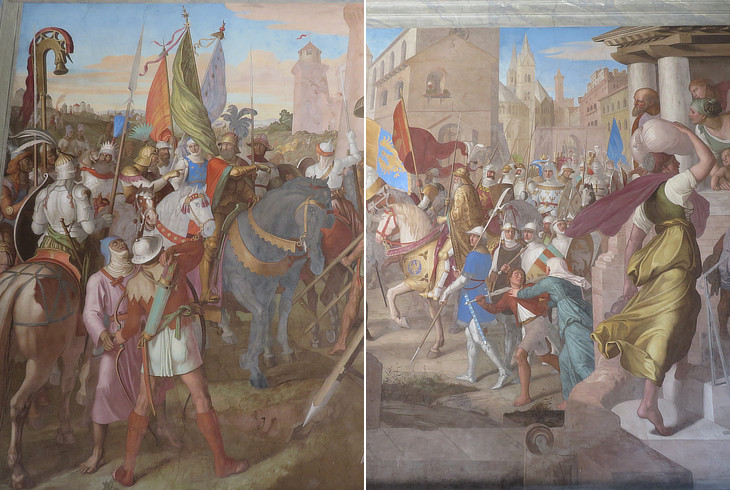
Ariosto's Room: Julius Schnorr von Carolsfeld - Canto XV: (left) Agramante and his army of Saracens and other Muslim warriors siege Paris; (right) Charlemagne and his knights are inside the walls of the city (see Raphael's Incendio di Borgo with a similar woman in the foreground - it opens in another window)
Agramante, meanwhile, had launched a force
Of substantial size, against a city gate;
For as that cruel battle ran its course,
In which so many men had met their fate,
He thought it undefended or, perforce,
So weakly manned, his soldiers need not wait.
(..)
But all proved contrary; against the foe,
(This King of Africa) the Emperor stood;
Within the walls his person he did show,
With many a knight, to make his mission good.
Some of the characters of Ariosto's poem became so popular that they were referred to by other authors.
He went on, saying: " Did I not tell you, sirs, that this castle was enchanted, and that some legion of devils must inhabit it? Behold the confirmation of what I said! Mark, with your own eyes, how the discord of Agramante's camp is transferred hither amongst us! there they fight for the sword, here for the horse, yonder for the eagle, here again for the helmet: we all fight, and no one understands another.
Miguel de Cervantes Saavedra - Don Quixote - Chapter XXXVI - publish'd by Peter Motteux. 1725
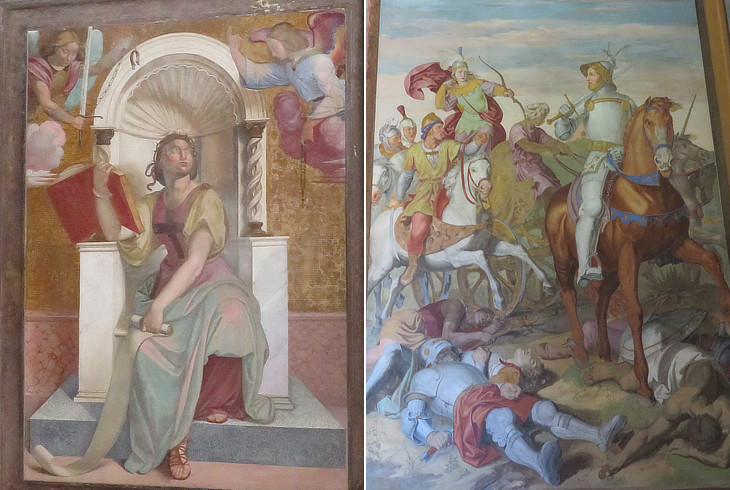
Tasso's Room: (left) Johann Friedrich Overbeck: Allegory of Jerusalem Delivered (1819) (Canto I); (right) Joseph von Fuhrich: Rinaldo and Armida in the battlefield (1827-1828) (Canto XX)
Palazzo Cenci, an immense and gloomy pile of massive architecture, was for many years deserted and left without doors or windows or any sign of human habitation. (..) Within the last few years, however, it has been made habitable, and a part of it was long occupied as a studio by the celebrated German painter Overbeck.
John Murray - A handbook of Rome and its environs - 1858
Johann Friedrich Overbeck (1789-1869) came to Rome in 1810 with the aim of developing a truly Christian art and in 1813 he converted to Catholicism. His works were highly praised in ecclesiastical circles and Pope Pius IX paid a visit to his studio. He lived and worked in Rome until his death, but the great majority of his paintings are in Germany.
Joseph von Fuhrich (1800-1876) was the youngest of the painters who worked at the Casino. He came to Rome in 1826 and he befriended with Overbeck who asked him to complete the decoration of the Tasso's Room. He then went to Prague and other cities of the Austrian Empire and eventually he became a professor in the Academy of Vienna.
Canto I
O heavenly Muse, that not with fading bays
Deckest thy brow by the Heliconian spring,
But sittest, crown'd with stars' immortal rays,
In heaven, where legions of bright angels sing,
Inspire life in my wit, my thoughts unpraise
My verse ennoble, and forgive the thing,
If fictions light I mix with truth divine,
And fill these lines with others' praise than thine.
Canto XX
Rinaldo came where his forlorn Armide
Sat in her golden chariot mounted high,
A noble guard she had on every side
Of lords, of lovers, and much chivalry:
She knew the man when first his arms she spy'd;
Love, hate, wrath, sweet desire, strove in her eye.
He chang'd some deal his look and countenance bold;
She chang'd from frost to fire, from heat to cold.
Translation by Edward Fairfax (1600)
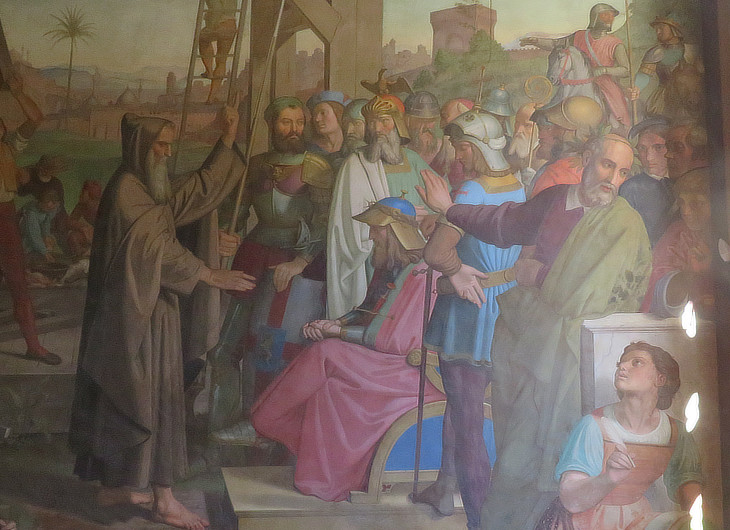
Tasso's Room: Johann Friedrich Overbeck: Godfrey of Bouillon is appointed leader of the Crusaders by Peter the Hermit (1825) (Canto I); the old man with the laurel wreath is Torquato Tasso dictating his poem to a Raphaelesque scribe; next to him Overbeck (the man in black) and Prince Massimo. See an early XVIIth century painting depicting a similar scene at Palazzo Chigi of Ariccia
This said, the hermit Peter rose and spake
Who sat in counsel those great lords among,
"At my request this war was undertake,
In private cell who erst liv'd closed long;
What Godfrey wills, of that no question make,
There cast no doubts where truth is plain and strong.
Your acts, I trust, will correspond his speech,
Yet one thing more I would you gladly teach. (..)
Of friendly parts one body, then, uphold,
Create one head the rest to rule and guide,
To one the regal power and scepter give,
That henceforth may your king and sovereign live. (..)
By this a virtuous concord they did choose,
And all contentions then began to die;
The princes with the multitude agree,
That Godfrey ruler of those wars should be.
See a page on the Christian conquest of Jerusalem and another one providing some historical and geographical background information on the Crusades.
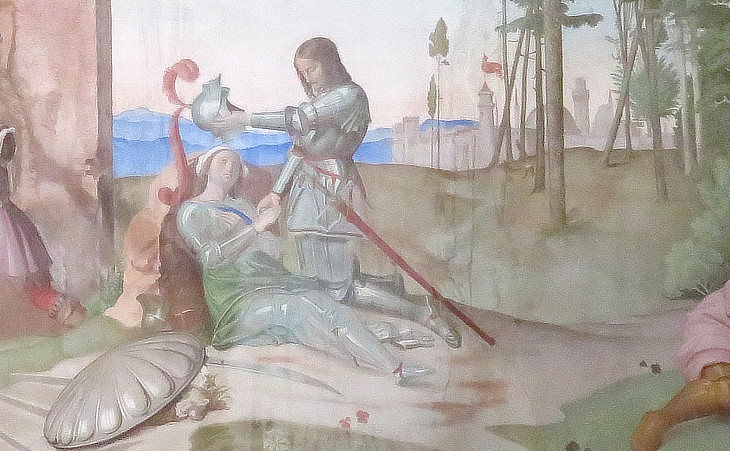
Tasso's Room: Johann Friedrich Overbeck: Baptism of Clorinda by Tancredi and her death (Canto XII) (see another episode involving Tancredi in a painting by il Guercino)
But now, alas! the fatal hour arrives
That her sweet life must leave that tender hold;
His sword into her bosom deep he drives,
And bath'd in lukewarm blood his iron cold;
Between her breasts the cruel weapon rives
Her curious square embost with swelling gold;
Her knees grow weak, the pains of death she feels,
And, like a falling cedar, bends and reels.
The Prince his hand upon her shield doth stretch,
And low on earth the wounded damsel laith,
And while she fell, with weak and woful speech
Her final prayers and last complaints she saith:
A spirit new did her those prayers now teach,
Spirit of hope, of charity, and faith;
And though her life to Christ rebellious were,
Yet died she still his child and handmaid dear.
"Friend, thou hast won; I pardon thee; nor save
This body, that all torments can endure,
But save my soul; baptism I dying crave,
Come, wash away my sins with waters pure."
His heart relenting nigh in sunder rave,
With woful speech of that sweet creature;
So that his rage, his wrath, and anger died,
And on his cheeks salt tears for ruth down slide.
Gerusalemme Liberata is about the storming of
Jerusalem by the Crusaders in 1099, but it also includes tales of love between Christian knights (Rinaldo and Tancredi) and Muslim heroines (Armida and Clorinda); the popularity of the poem is chiefly due to these tales.
Venice, Oct. 6, 1786, I made arrangements to hear the famous singing of the boatmen of Venice, who chant verses by Tasso and Ariosto. My old boatman wished that I could hear the women of the Lido, especially those of Malamocco, and Pelestrina. These also, he told me, chaunted Tasso and Ariosto to the same or similar melody. He went on; "in the evening, while their husbands are on the sea fishing, they are accustomed to sit on the beach, and with shrill-penetrating voice to make these strains resound, until they catch from the distance the voices of their partners, and in this way they keep up a communication with them." Is not that beautiful? and yet, it is very possible that one who heard them close by, would take little pleasure in such tones which have to vie with the waves of the sea. Human, however, and true becomes the song in this way: thus is life given to the melody, on whose dead elements we should otherwise have been sadly puzzled. It is the song of one solitary, singing at a distance, in the hope that another of kindred feelings and sentiments may hear and answer. Goethe

Tasso's Room: Joseph von Fuhrich: Godfrey of Bouillon at the Holy Sepulchre (Canto XX)
His bloody coat he put not off, but run
To the high temple with his noble train,
And there hung up his arms, and there he bows
His knees, there prayed, and there perform'd his vows.
End of the poem.
Rome, Feb 21, 1787, Of all my unfinished poetical works I shall take with me none but the "Tasso," of which I have the best hopes. Goethe
Torquato Tasso, a play in verse was completed by Goethe in 1790.
Tasso's eye scarce rests upon this earth;
His ear drinks in all nature's harmonies;
- What history supplies, and life presents,
He willingly hoards up within his breast;
His mind assorts the scattered elements,
His ardour animates the lifeless mass.
Oft he ennobles what seems mean to us,
And sets at nought what we most highly prize.
Within this magic circle wandering
The gifted man attracts, and draws us on
To wander with him and to take a part.
Goethe - Torquato Tasso - translation by J. Cartwright
Return to Villa Giustiniani Massimo.
Next plate in Book 10: Casino della Villa Mattei.
Next step in Day 2 itinerary: Chiesa de' SS. Vito e Modesto.
Next step in your tour of Rione Monti: Porta Maggiore.

